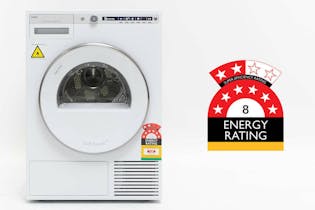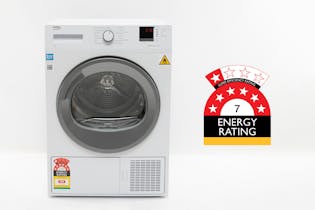Spindel dryer - a revolutionary way to dry your clothes?

A spin-dryer uses spinning force to fling water out of damp clothes – think of a salad spinner, but for your laundry. These machines are roughly the size of a kitchen bin and speed up the drying process by removing excess moisture.
Spin-dryers have been around since the 1960s, but there’s a new plastic-housed model out called the Spindel (great name). It retails at $339 from https://www.spindel.nz/ and promises to save you money and speed up your laundry day too.
So how does the Spindel perform, and should you bother getting one if you already spin your clothes in a washing machine?

Spindel pros and cons
Pros
- Removes a reasonable amount of excess moisture that would otherwise evaporate into your home.
- Works very quickly – only 3 minutes removes a decent amount of moisture and allowing it to run longer will remove even more.
- Energy efficient – the motor is only 300W, so a 10-minute spin cycle would only cost around 1c.
- Lightweight (8.7kg) and compact – it’s easy to store and setup when you need it.
- Relatively quiet – we measured roughly 61 decibels (dB) in use, which is just over the noise level of a normal conversation between two people one metre away.
- Won’t damage your clothes, which can be a problem with some fabrics in heated clothes dryers.
- Very simple to use.
Cons
- Low capacity – despite claims saying it can take 6.5kg of wet washing, we reckon you’d only be able to spin around half that weight in one go.
- Only speeds up line drying by 15–20% of normal drying time.
- The product has a cheap plastic feel.
- If you spend slightly more, you could buy a tumble dryer that will fully dry your clothes.
How does the Spindel work?
The Spindel is a basic machine with one control that locks the lid and turns on the motor. You can use it to remove moisture from machine or handwashed clothes. A motor spins the clothes at 2,800 revolutions per minute (rpm) – this is over twice the spin speed of most washing machines. Excess water drips out of a drain at the bottom of the Spindel, and you need to place a bowl here to catch it. It’s very satisfying to see the amount of water that is removed!

Capacity tests
Our 3.1kg and 2.5kg loads of wet washing pushed the Spindel to its limits, leaving us doubting it meets its claims of 6.5kg capacity.
For our first test, we washed three new standard cotton bath towels a few times to make sure they absorbed water properly. We popped the three wet towels, weighing 3.1kg, into the Spindel to dry. However, the unit shook and danced around the floor, and the towels couldn’t effectively spin as they were too tightly packed. Dropping down to two towels sorted this problem and the Spindel started extracting water.
Then, we washed a small mixed load of clothes – three pairs of socks, six T-shirts, a pair of shorts and a long sleeve shirt. Despite this small load weighing only 2.5kg when wet, it nearly filled the dryer, leaving us doubting the stated 6.5kg capacity of the Spindel.
A lot of laundry products have overstated capacity claims though. From our surveys, we find the average load is around 3.5kg, so the Spindel would likely be just about able to handle that amount for a mixed load.

Drying tests
To test the drying claims, we used the towels and mixed load from the capacity test and also tested two identical T-shirts.
Towels
We washed two towels in a front loader with a final spin cycle of 1,200rpm.
One was spun for 10 minutes in the Spindel (we figured most people would be happy to run the unit for longer than 3 minutes considering it’s so cheap to run).
A 10-minute spin removed around 160ml of excess moisture – quite a lot! But what does this mean in the real world? We hung up both towels on a drying rack in the Consumer NZ office and weighed them both every hour to work out how much quicker the Spindel towel dried. Room temperature during drying was around 22°C with humidity varying between 57% and 64%.
Spindel speeds up towel drying by 2 hours
The graph shows that after 9 hours the towel that had the extra spin was dry. The other towel took an additional 2 hours to dry to the same level. So, the Spindel improved drying time by about 20%.
T-shirts
The test was repeated with two identical T-shirts to see if the same speed improvement was applicable to other, thinner fabrics.
Spindel speeds up t-shirt drying by 1.5 hours
The Spindel spun T-shirt was dry in around 3.5 hours, the non-spun shirt took around 4.5 hours to dry. Again, an improvement in drying time of around 20%.
Should I buy a Spindel?
Spindel’s marketing claims that fabrics will “air dry in a fraction of the time”, which is true as long as that fraction is four-fifths – as it’s only around 20% quicker.
Comparisons to a tumble dryer are also a little misleading as a tumble dryer can completely dry your garments, whereas the Spindel can’t. The capacity claims should be taken with a pinch of salt too.
So, should you buy a Spindel? Well, if you want to dry clothes quickly you should probably buy a clothes dryer, but if you don’t have the space for one and need to do a lot of indoor drying, dry handwashed items, or want to use your current dryer less, then the Spindel might be for you.
The Spindle trialled was loaned to Consumer NZ by Spindle.
We've tested 71 clothes dryers.
Find the right one for you.



Member comments
Get access to comment